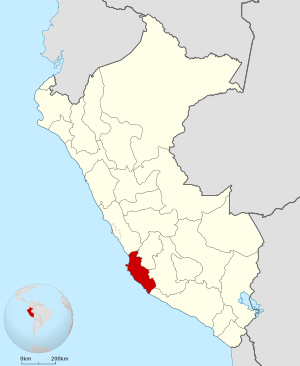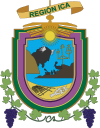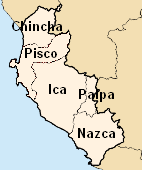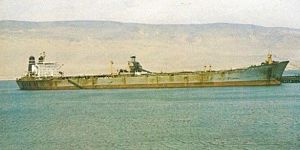Department of Ica facts for kids
Quick facts for kids
Department of Ica
|
|||
|---|---|---|---|

Nazca Lines: "Dog"
|
|||
|
|||

Location of the Ica Region in Peru
|
|||
| Country | Peru | ||
| Subdivisions | 5 provinces and 43 districts | ||
| Capital | Ica | ||
| Area | |||
| • Total | 21,327.83 km2 (8,234.72 sq mi) | ||
| Elevation
(Capital)
|
406 m (1,332 ft) | ||
| Highest elevation | 3,796 m (12,454 ft) | ||
| Lowest elevation | 0 m (0 ft) | ||
| Population
(2017)
|
|||
| • Total | 850,765 | ||
| • Density | 39.88990/km2 (103.31437/sq mi) | ||
| Dialing code | 056 | ||
| ISO 3166 code | PE-ICA | ||
| Principal resources | Iron, cotton, grapevine, kidney beans. | ||
| Poverty rate | 41.7% | ||
| Percentage of Peru's GDP | 2.36% | ||
| Website | www.regionica.gob.pe | ||
Ica (Spanish pronunciation: [ˈika]) is a special region in Peru. It is located on the southern coast of the country. The region borders the Pacific Ocean to the west. To the north, it meets the Lima Region. On the east, you'll find the Huancavelica and Ayacucho regions. Finally, the Arequipa Region is to the south. The main city and capital of this region is Ica.
Contents
Exploring Ica's Unique Geography
The Ica region has a very interesting landscape. It is the only part of Peru's southern coast that is mostly flat. This is because the Andes mountains rise further inland here.
Sand Dunes and Deserts
You can find many moving sand dunes in Ica. These dunes stretch all the way to the sea, forming places like the Paracas Peninsula. In the southern part, there are huge deposits of iron. These are some of the biggest iron mines on the Pacific Ocean coast.
Rivers and Winds
Ica's shape is also due to its two main rivers, the Pasco and Ica rivers. There is also a waterway called the Rio Grande. However, its water often does not reach the ocean. This is because it is used for farming, and the dry land absorbs the rest. Ica has large desert areas, like the Lancha Pampas. Some areas, like Pozo Santo and Villacuri, get extremely hot. Strong winds called paracas often blow here. These winds can create big sandstorms.
A Journey Through Ica's History
Ica has a very long and rich history. People first lived here about 10,000 years ago. Over time, several important ancient cultures developed in this area.
Ancient Cultures of Ica
- Paracas Culture: This culture lived from about 700 BC to 200 BC. They were amazing at making textiles (fabrics). They also knew how to perform special surgeries called trephinations. They were skilled at preserving their dead through mummification.
- Nazca Culture: The Nazca culture thrived from 200 BC to 700 AD. They are famous for their colorful pottery with unique designs. They also created the mysterious Nazca Lines. The Nazca people were very smart engineers. They built amazing aqueducts to use underground water for farming.
Incas and Spanish Arrival
In the 15th century, the great Inca empire expanded into Ica. The Inca ruler Pachacuti added the lands of Ica, Nazca, and the Chincha valley to his empire. Later, in 1563, the Spanish arrived. Jerónimo Luis de Cabrera founded the city of Villa de Valverde del Valle de Ica. From then on, the area became important for growing grapes (for wine) and cotton.
Peru's Independence
During the fight for Peru's independence, General José de San Martín landed in Paracas. He set up his base in Pisco to begin the fight for freedom.
How Ica is Organized
The Ica region is divided into five main areas called provinces. These provinces are then split into 43 smaller parts called districts.
Provinces of Ica
Here are the provinces in the Ica region, with their main cities in parentheses:
Must-See Places in Ica
The Ica region is full of exciting places to visit!
Ica City: The Capital
The city of Ica is the capital of the Ica Department. It's a modern and clean city. You can explore Peruvian street markets and see many old churches. There are also modern malls, hotels, and coffee shops.
Huacachina Oasis: Desert Fun
One of the most popular spots is Huacachina. This amazing desert oasis is only about 5 kilometers from Ica city. It's a small lake with special healing waters. It sits right in the middle of a stunning sand desert. It's a great place for sandboarding!
Pisco: A Historic Port
Pisco is the most important port in the Ica region. It's also a coastal province. Key attractions here include Paracas and the Paracas National Reserve. Pisco was once home to the ancient Paracas culture, known for their incredible textiles.
Paracas: Wildlife and History
Paracas is a small town perfect for tourists. It's the starting point for boat tours to the Islas Ballestas. These islands are sometimes called the "mini-Galapagos" because they are full of wildlife. You can also visit the Paracas National Reservation. The Paracas Museum teaches you about the ancient Paracas culture and the unique animals, especially the many birds, found in the area.
Nazca: Mysterious Lines and Ancient Wonders
The Ica-Nazca culture lived along Peru's southern coast from about 200 BC to 600 AD. This area is very dry. The Nazca people built amazing irrigation systems, including underground canals. This allowed them to farm the land. They are also known for their textiles and pottery, which show animals and mythical creatures.
The Famous Nazca Lines
Even more famous are the Nazca Lines. These are huge drawings made on the desert floor in the Atacama desert. The Nazca people scraped away dark stones to show the lighter soil underneath. These drawings show plants, animals (like monkeys and birds), humans, and geometric shapes. They are so big that you can only see them properly from the sky! Scientists believe the Nazca made these drawings for their gods. This area is called the Pampa Colorada, or "red plain."
Cachiche: The Village of Witches
Cachiche is a small village close to Ica. It is famous for its history of witches! A woman named Doña Julia was known as Cachiche's first witch. People believed she used "good magic" to help villagers and cure them. Near the town's entrance, you can see a carving from a single huarango tree. It shows this first "bruja de Cachiche" (witch of Cachiche).
Fun Things to Do in Ica
Ica is well-known for its wine and pisco (a type of grape brandy) industries. You can visit vineyards and learn how these drinks are made. The region also has fun annual festivals. The weather is usually sunny and dry, which is great for exploring.
Desert Adventures
Since 2020, the Peruvian desert around the Huacachina Oasis has become very popular. Tourists love to go sandboarding down the huge dunes. You can also take exciting sand buggy tours across the desert.
Regional Museum
There is a Regional Museum in Ica. It shows ancient items from prehistoric times. You can also see paintings and furniture from when the Spanish ruled Peru. The museum even has mummies with the unique skull shapes typical of the Paracas culture.
See also
 In Spanish: Departamento de Ica para niños
In Spanish: Departamento de Ica para niños
- 2007 Peru earthquake
- Lost City of Huayuri, Pre-Columbian archaeological site
- Pernil Alto, Pre-Columbian archaeological site







